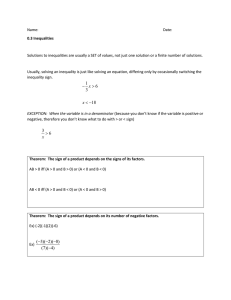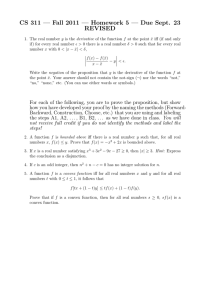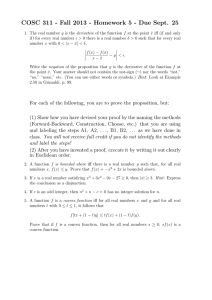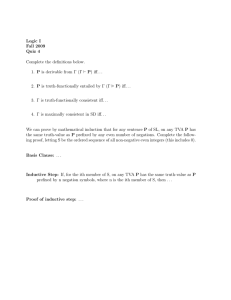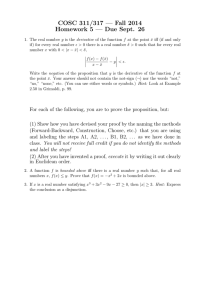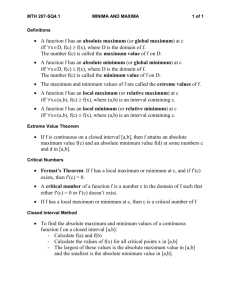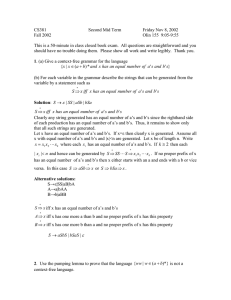Solutions for Problem Set 1
advertisement
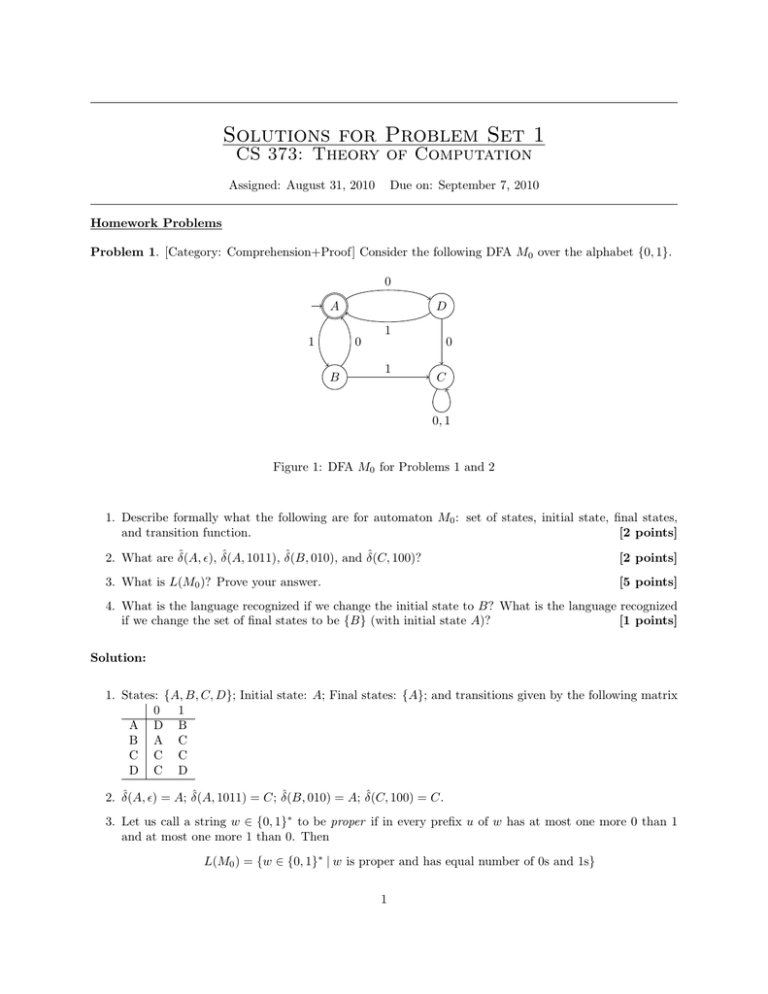
Solutions for Problem Set 1
CS 373: Theory of Computation
Assigned: August 31, 2010
Due on: September 7, 2010
Homework Problems
Problem 1. [Category: Comprehension+Proof] Consider the following DFA M0 over the alphabet {0, 1}.
0
A
D
1
1
0
B
0
1
C
0, 1
Figure 1: DFA M0 for Problems 1 and 2
1. Describe formally what the following are for automaton M0 : set of states, initial state, final states,
and transition function.
[2 points]
2. What are δ̂(A, ), δ̂(A, 1011), δ̂(B, 010), and δ̂(C, 100)?
[2 points]
3. What is L(M0 )? Prove your answer.
[5 points]
4. What is the language recognized if we change the initial state to B? What is the language recognized
if we change the set of final states to be {B} (with initial state A)?
[1 points]
Solution:
1. States: {A, B, C, D}; Initial state: A; Final states: {A}; and transitions given by the following matrix
0 1
A D B
B A C
C C C
D C D
2. δ̂(A, ) = A; δ̂(A, 1011) = C; δ̂(B, 010) = A; δ̂(C, 100) = C.
3. Let us call a string w ∈ {0, 1}∗ to be proper if in every prefix u of w has at most one more 0 than 1
and at most one more 1 than 0. Then
L(M0 ) = {w ∈ {0, 1}∗ | w is proper and has equal number of 0s and 1s}
1
We will establish by induction on |w| the following statements
(a) δ̂(A, w) ∈ {A} iff w ∈ L(M0 )
(b) δ̂(B, w) ∈ {A} iff w = 0u where u ∈ L(M0 )
(c) δ̂(C, w) ∈ {A} iff w ∈ ∅
(d) δ̂(D, w) ∈ {A} iff w = 1u where u ∈ L(M0 )
Base Case: Since |w| = 0, we know that w = . Observe that ∈ L(M0 ) and δ̂(q, ) = q for any
q ∈ {A, B, C, D}. Thus, δ̂(q, ) ∈ {A} iff q = A, establishing all the four statements.
Induction Hypothesis: Assume that (a),(b),(c),(d) hold for strings w of length i.
Induction Step: Consider w of length i + 1. Without loss of generality, we may assume that w = av,
where a ∈ {0, 1} and v is of length i. We have a few subcases to consider.
Subcase 1: Observe that δ̂(A, 0v) = δ̂(δ(A, 0), v) (by the proposition that we proved in class. Thus,
we have
δ̂(A, 0v) ∈ {A}iff δ̂(D, v) ∈ {A}
(δ(A, 0) = D)
iff v = 1u where u ∈ L(M0 )
(ind. hyp.)
iff w = 0v ∈ L(M0 )
The other subcases are similar.
Subcase 2: Again, δ̂(A, 1v) ∈ {A} iff δ̂(B, v) ∈ {A} iff v = 0u where u ∈ L(M0 ) iff w = 0v ∈ L(M0 ).
Subcase 3: δ̂(B, 0v) ∈ {A} iff δ̂(A, v) ∈ {A} iff v ∈ L(M0 ).
Subcase 4: δ̂(B, 1v) ∈ {A} iff δ̂(D, v) ∈ {A} iff v ∈ ∅.
Subcase 5: For any a ∈ {0, 1}, δ̂(C, av) ∈ {A} iff δ̂(C, v) ∈ {A} iff v ∈ ∅ iff w = av ∈ ∅.
Subcase 6: δ̂(D, 0v) ∈ {A} iff δ̂(C, v) ∈ {A} iff v ∈ ∅.
Subcase 7: δ̂(D, 1v) ∈ {A} iff δ̂(A, v) ∈ {A} iff v ∈ L(M0 ).
4. When the initial state is changed to B the language is
{w ∈ {0, 1} | w = 1u where u ∈ L(M0 )}
Here L(M0 ) refers to the set defined in the previous part. When the set of final states is changed to
{B}, the language is
{w ∈ {0, 1}∗ | w = u1 where u ∈ L(M0 )}
Problem 2. [Category: Comprehension+Proof] Given a DFA M = (Q, Σ, δ, q0 , F ) define the following
function ρ : Q × Σ∗ → 2Q inductively. (Recall, 2Q is the power set of Q.)
{q}
if w = ρ(q, w) =
{q 0 | δ(q 0 , a) ∈ ρ(q, u)} if w = au
where u ∈ Σ∗ and a ∈ Σ. Answer the following questions about ρ and the DFA M0 from problem 1.
1. What is ρ(A, ), ρ(A, 1011), ρ(B, 010), and ρ(C, 100)?
[2 points]
2. Give an english/mathematical description of what ρ is for a general DFA.
[1 points]
2
3. For a DFA M , define L0 (M ) = {w ∈ Σ∗ | ∃q ∈ F. q0 ∈ ρ(q, w)}. For each of the following answer
whether the belong to L0 (M0 ): 0110, 101?
[1 points]
4. What is L0 (M0 )?
[1 points]
5. For a general DFA M , what is the relationship between L(M ) and L0 (M )? (Answer which of the
following best describes the relationship: L(M ) = L0 (M ), L(M ) ⊆ L0 (M ) or L0 (M ) ⊆ L(M ).) Prove
your answer.
[5 points]
Solution:
1. ρ(A, ) = {A}; ρ(A, 1011) = ∅; ρ(B, 010) = ∅; ρ(C, 100) = {B, C, D}.
2. ρ(q, w) = {q 0 ∈ Q | δ̂(q 0 , w) = q}
3. 0110 ∈ L0 (M0 ) and 101 6∈ L(M00 )
4. L0 (M0 ) = L(M0 ), where L(M0 ) is the set defined in the previous problem.
5. In general, L0 (M ) = L(M ). Let us assume that the definition of ρ given in part 2 is correct; we will
prove this later by induction. Assuming that, we have
w ∈ L(M )iff δ̂(q0 , w) ∈ F
(defn. of L(M ))
iff ∃q ∈ F. δ̂(q0 , w) = q
iff ∃q ∈ F. q0 ∈ ρ(q, w)
0
(part 2 to be proved)
(defn. of L0 (M ))
iff w ∈ L (M )
Now we will prove for any q ∈ Q and w ∈ Σ∗ , ρ(q, w) = {q 0 | δ̂(q 0 , w) = q}
Base Case: Consider w of length 0, i.e., w = . ρ(q, ) = {q} = {q 0 | δ̂(q 0 , ) = q} as δ̂(q 0 , ) = q 0 .
Induction Hypothesis: Assume that the observation holds for strings w of length i.
Induction Step: Consider w = au, where |u| = i and a ∈ Σ.
ρ(q, au) = {q 0 | δ(q 0 , a) ∈ ρ(q, u)}
(defn. of ρ)
{q 0 | ∃q 00 . δ(q 0 , a) = q 00 and δ̂(q 00 , u) = q}
0
(ind. hyp.)
0
{q | δ̂(δ(q , a), u) = q}
{q 0 | δ̂(q 0 , au) = q}
(proposition about δ̂)
Problem 3. [Category: Design] [Modified version of problem 1.32 of text book] Let
0
0
0
1
0
Σ3 = 0 , 0 , 1 , 1 , . . . 1
0
1
0
1
1
Σ3 contains all size 3 columns of 0s and 1s.
each row to be a binary number, where the
For example, the string
0
1
1
A string of symbols in Σ3 gives 3 rows of 0s and 1s. Consider
first symbol is the least significant bit of each binary number.
1
1
0
1 0 0
0
0
1
3
represents 0110 = 6 (first row), 0011 = 3 (second row) and 1001 = 9 (third row). Let
B = {w ∈ Σ3 | the bottom row of w is the sum of the top two rows}
For example,
0
1
1
0
1 1 0 0 ∈ B
1
0
0
1
but
0
1
1 0 ∈
6 B
0
1
Design a DFA that recognizes B. You need not formally prove the correctness of your construction; however,
your construction should be clear and understandable.
[10 points]
Solution: We will assume that ∈ B. The DFA MB recognizing B will remember the “carry” from the
previous bit position. Thus, there will be 2 states qi (for i{0, 1}) denoting that the carry from the input seen
so far is i. In addition, we will need to have an “error” state qe to denote that an error in the sum has been
discovered. So formally, MB = (Q, Σ3 , δ, q0 , F ) where
• Q = {q0 , q1 , qe },
• F = {q0 }, and
• δ is given as follows.
(
a
q(a+b+i) div 2
δ(qi , b ) =
qe
c
if i ∈ {0, 1}, and c = (a + b + i) mod 2
otherwise
4
